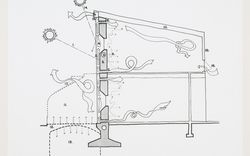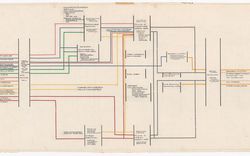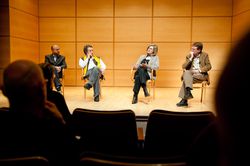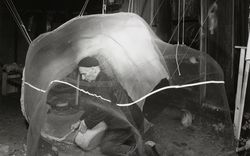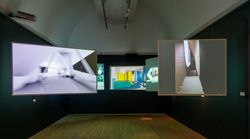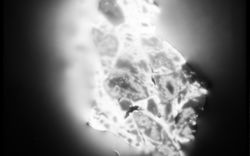Sub-series
AP178.S1.1988.PR07.SS9
Description:
This project series documents the restoration of the Grandes Armazéns do Chiado building in Lisbon, Portugal. While the records were held in the office’s archives this project was assigned the number 58/80 N4. The office assigned the dates 1988-1998 for this project. The Grandes Armazéns do Chiado was part of Bloco C and identified as building 4 in Siza's reconstruction plan. The site of the Grandes Armazéns served several different functions in its history, including a hotel, a palace, and a convent, before becoming a department store in 1894. In the 1920s, a hotel was created at the top floors. After the destructive fire of 1988, the new owners of the building were interested in using the totality of the building for a shopping mall and restaurants. On the other hand, Siza's proposal included the expansion of the hotel in the building to introduce more public activity in the area after the regular work and shopping hours. Several programs were proposed to the owners of the building, and it was decided in 1996 that the hotel space would be reduced to the two top floors to have more room for the shopping center. The new division included 41 hotel rooms and 41 stores. The interior of the shopping mall was designed by Eduardo Souto Moura. Drawings include studies, working drawings, mechanical drawings, and structural drawings. Textual material includes project documentation, studies, meeting reports, and correspondence. Photographic material includes photographs of the building before the fire, ruins, model, and construction work. Documentation for this project can also be found in subseries AP178.S1.1988.PR07.SS1 and AP178.S1.1988.PR07.SS7 of this project series.
1988-2000
Recuperação do Edifício dos Grandes Armazéns, Bloco C, Reconstrução do Chiado [Restoration of Grandes Armazéns do Chiado building, Block C, Reconstruction of the Chiado] Lisbon, Portugal (1988-1998)
Actions:
AP178.S1.1988.PR07.SS9
Description:
This project series documents the restoration of the Grandes Armazéns do Chiado building in Lisbon, Portugal. While the records were held in the office’s archives this project was assigned the number 58/80 N4. The office assigned the dates 1988-1998 for this project. The Grandes Armazéns do Chiado was part of Bloco C and identified as building 4 in Siza's reconstruction plan. The site of the Grandes Armazéns served several different functions in its history, including a hotel, a palace, and a convent, before becoming a department store in 1894. In the 1920s, a hotel was created at the top floors. After the destructive fire of 1988, the new owners of the building were interested in using the totality of the building for a shopping mall and restaurants. On the other hand, Siza's proposal included the expansion of the hotel in the building to introduce more public activity in the area after the regular work and shopping hours. Several programs were proposed to the owners of the building, and it was decided in 1996 that the hotel space would be reduced to the two top floors to have more room for the shopping center. The new division included 41 hotel rooms and 41 stores. The interior of the shopping mall was designed by Eduardo Souto Moura. Drawings include studies, working drawings, mechanical drawings, and structural drawings. Textual material includes project documentation, studies, meeting reports, and correspondence. Photographic material includes photographs of the building before the fire, ruins, model, and construction work. Documentation for this project can also be found in subseries AP178.S1.1988.PR07.SS1 and AP178.S1.1988.PR07.SS7 of this project series.
Project
1988-2000
articles
articles
Curatorial practice as it emerged during the twentieth century is no doubt being extensively recast. The tremendous change in the status of the object, of culture, of the various disciplines, or information and education, implies an inevitable transformation of the curator’s role and competences. A renewed interest for curatorial practice has emerged within the field of(...)
Paul Desmarais Theatre
11 November 2010 to 13 November 2010
The CCA in an Expanding Curatorial Field
Actions:
Description:
Curatorial practice as it emerged during the twentieth century is no doubt being extensively recast. The tremendous change in the status of the object, of culture, of the various disciplines, or information and education, implies an inevitable transformation of the curator’s role and competences. A renewed interest for curatorial practice has emerged within the field of(...)
Paul Desmarais Theatre
articles
Jia Gu, Hannah Rose Feniak, Matthey Critchley, Aldo Rossi, Frederick Kiesler, Eero Saarinen
20 July 2020
Archaeology of the Digital: Complexity and Convention is the third exhibition related to the development of a strategy for collecting and preserving digital archives at the CCA. The Archaeology of the Digital program comprises twenty-five projects for which digital materials are integral to an understanding of the design process. For projects included in the first two(...)
11 May 2016 to 16 October 2016
Archaeology of the Digital: Complexity and Convention
Actions:
Description:
Archaeology of the Digital: Complexity and Convention is the third exhibition related to the development of a strategy for collecting and preserving digital archives at the CCA. The Archaeology of the Digital program comprises twenty-five projects for which digital materials are integral to an understanding of the design process. For projects included in the first two(...)
Series
AP195.S3
Description:
Series 3: Construction working files and related correspondence, 1996 – 2015, contains CAD files and related textual records documenting the evolution of the Phaeno Science Centre project over time, particularly during the construction and post-construction phases. Formats represented include chiefly CAD drawings (plotter files, AutoCAD drawings, DXF), as well as text documents (Microsoft Word, Microsoft Excel, PDF, plain text) and images (JPEG, TIFF). There is also a significant amount of email correspondence (MSG, MBOX). The bulk of the materials dates from 2000 – 2005. The materials in this series chiefly consist of project working files by year from 2002 to 2015 (non-inclusive). These directories primarily consist of plotter files and other construction drawings in CAD formats, both sent and received by ZHA. Alongside the drawings, there is also often a significant body of textual material, including email correspondence, memoranda, meeting minutes, translations, legal documentation, and other administrative material. Taken altogether, the working files provide insight into the construction of the Phaeno Science Centre as it evolved over time. In addition to the working files, there are also a number of other files arranged topically. This includes material for construction permit applications, invoices to the client and contractors, construction schedules and pricing, materials related to consultants, and additional detail drawings. Notably, this series also contains the email archives of Sara Klomps, a project architect for the Phaeno Science Centre from the early 2000s through at least 2015. These materials reflect her work on the project, particularly communication with the client and consultants, as well as the arc of her career at ZHA, where she became associate director in 2014.
1996 - 2015
Construction working files and related correspondence
Actions:
AP195.S3
Description:
Series 3: Construction working files and related correspondence, 1996 – 2015, contains CAD files and related textual records documenting the evolution of the Phaeno Science Centre project over time, particularly during the construction and post-construction phases. Formats represented include chiefly CAD drawings (plotter files, AutoCAD drawings, DXF), as well as text documents (Microsoft Word, Microsoft Excel, PDF, plain text) and images (JPEG, TIFF). There is also a significant amount of email correspondence (MSG, MBOX). The bulk of the materials dates from 2000 – 2005. The materials in this series chiefly consist of project working files by year from 2002 to 2015 (non-inclusive). These directories primarily consist of plotter files and other construction drawings in CAD formats, both sent and received by ZHA. Alongside the drawings, there is also often a significant body of textual material, including email correspondence, memoranda, meeting minutes, translations, legal documentation, and other administrative material. Taken altogether, the working files provide insight into the construction of the Phaeno Science Centre as it evolved over time. In addition to the working files, there are also a number of other files arranged topically. This includes material for construction permit applications, invoices to the client and contractors, construction schedules and pricing, materials related to consultants, and additional detail drawings. Notably, this series also contains the email archives of Sara Klomps, a project architect for the Phaeno Science Centre from the early 2000s through at least 2015. These materials reflect her work on the project, particularly communication with the client and consultants, as well as the arc of her career at ZHA, where she became associate director in 2014.
Series
1996 - 2015
Sub-series
AP178.S1.2002.PR05.SS1
Description:
This project subseries documents the Parque de Vidago Complexo Termal e Hotel Palace in Vidago, Portugal. While the records were held in the office’s archives this project was assigned the number 49/00. The office assigned the date 2002 to this project. The project consisted of major renovations to update and modernize the Vidago Palace Hotel, originally opened in 1910, and the addition of a new thermal spa. Architects José Pedro Lopes Vieira and Diogo Rosa Lã were responsible for the interior decoration of the Palace Hotel, while Siza designed the Spa. The full or partial demolition of some parts of the hotel and nearby buildings was necessary to maintain the original character of the resort. In contrast to the historic hotel, the new spa was contemporary and minimalist with marble interiors. It included pools, Turkish baths, treatment and relaxation rooms, a gym, bars and meditation area. This project subseries is documented through drawings, photographic materials, study models and textual records dating from 2002-2012. These materials primarily document the spa but documentation for the surrounding site, Palace Hotel, Fonte Salus (spring), gatehouse and Serralves exhibition space is also included. The drawings are largely reprographic copies of printed CAD drawings and include sketches, studies, plans, details, sections, elevations, demolition drawings and mechanical, electrical and structural drawings. The textual records include correspondence, meeting minutes, studies, building programs, furniture and spa equipment documentation, budgets and contracts. A large amount of documentation on various electrical, structural and mechanical systems is also included. The photographic materials are mostly printed digital photos showing buildings across the site, pre and post construction work and reference images. There are also a number of photos, postcards and brochures showing historical images of the hotel.
2002-2012
Parque de Vidago, Complexo Termal e Hotel Palace [Vidago Palace Hotel and Spa], Vidago, Portugal (2002)
Actions:
AP178.S1.2002.PR05.SS1
Description:
This project subseries documents the Parque de Vidago Complexo Termal e Hotel Palace in Vidago, Portugal. While the records were held in the office’s archives this project was assigned the number 49/00. The office assigned the date 2002 to this project. The project consisted of major renovations to update and modernize the Vidago Palace Hotel, originally opened in 1910, and the addition of a new thermal spa. Architects José Pedro Lopes Vieira and Diogo Rosa Lã were responsible for the interior decoration of the Palace Hotel, while Siza designed the Spa. The full or partial demolition of some parts of the hotel and nearby buildings was necessary to maintain the original character of the resort. In contrast to the historic hotel, the new spa was contemporary and minimalist with marble interiors. It included pools, Turkish baths, treatment and relaxation rooms, a gym, bars and meditation area. This project subseries is documented through drawings, photographic materials, study models and textual records dating from 2002-2012. These materials primarily document the spa but documentation for the surrounding site, Palace Hotel, Fonte Salus (spring), gatehouse and Serralves exhibition space is also included. The drawings are largely reprographic copies of printed CAD drawings and include sketches, studies, plans, details, sections, elevations, demolition drawings and mechanical, electrical and structural drawings. The textual records include correspondence, meeting minutes, studies, building programs, furniture and spa equipment documentation, budgets and contracts. A large amount of documentation on various electrical, structural and mechanical systems is also included. The photographic materials are mostly printed digital photos showing buildings across the site, pre and post construction work and reference images. There are also a number of photos, postcards and brochures showing historical images of the hotel.
Project
2002-2012
research
Visiting Scholars 2000–2001
Theme: The Phenomenon of Paradigm Shifts in Architecture since Antiquity: Oliver Botar, School of Art, University of Manitoba, Winnipeg, Canada Topic: On Biocentrism and Modernism in Weimar German Architecture and Art Fabrizio Nevola, School of Architecture, Syracuse University Florence, Italy Topic: Siena, 1450-1520: From ‘Medieval’ to ‘Renaissance’ City Alessandra(...)
September 2000 to August 2001
Visiting Scholars 2000–2001
Actions:
Description:
Theme: The Phenomenon of Paradigm Shifts in Architecture since Antiquity: Oliver Botar, School of Art, University of Manitoba, Winnipeg, Canada Topic: On Biocentrism and Modernism in Weimar German Architecture and Art Fabrizio Nevola, School of Architecture, Syracuse University Florence, Italy Topic: Siena, 1450-1520: From ‘Medieval’ to ‘Renaissance’ City Alessandra(...)
research
September 2000 to
August 2001
articles
Material Witness
The Lives of Documents, Photography as a Project, Stefano Graziani and Bas Princen, Susanne Kriemann, conversation, oral history, radioactive landscapes
11 March 2024
